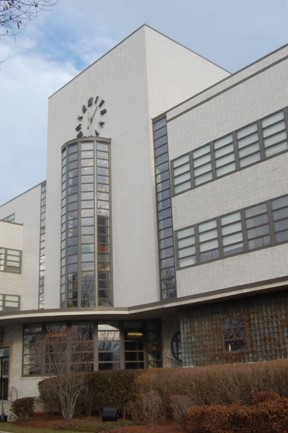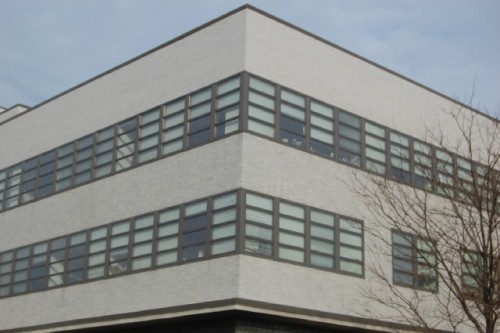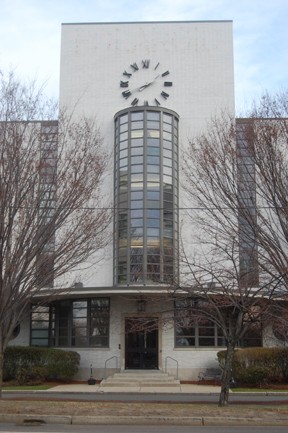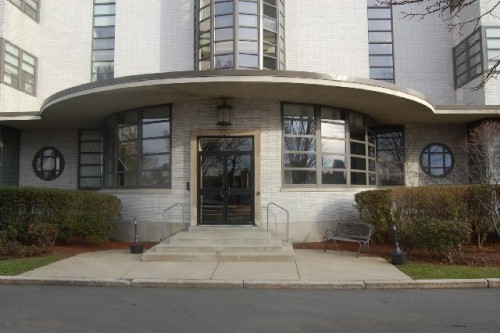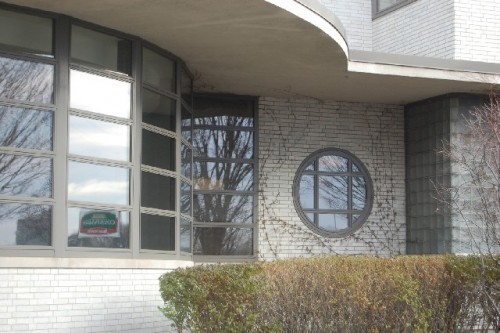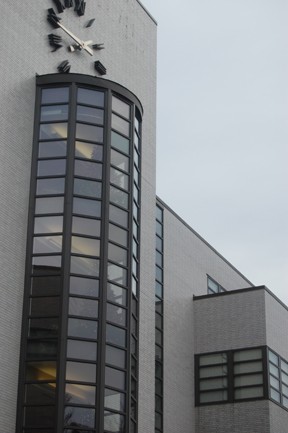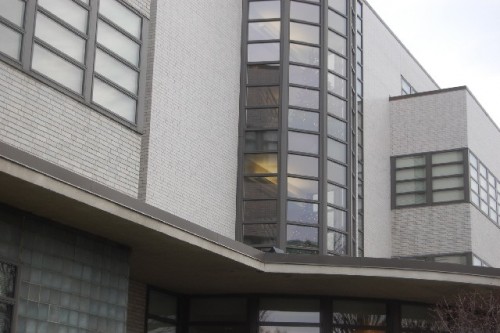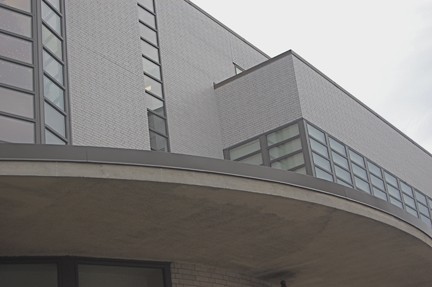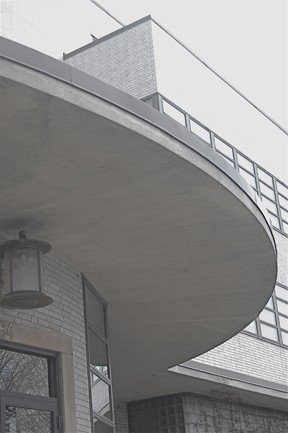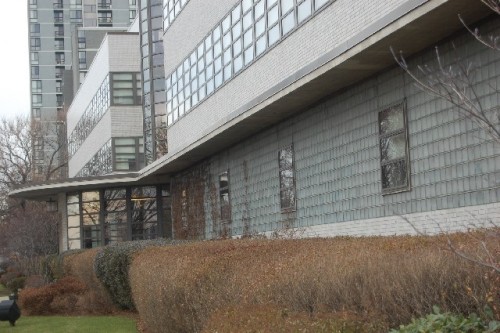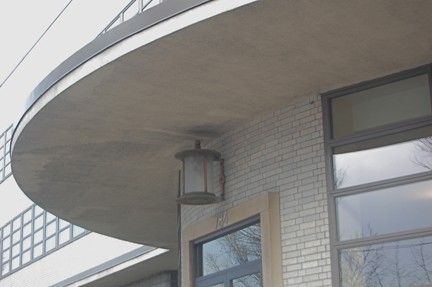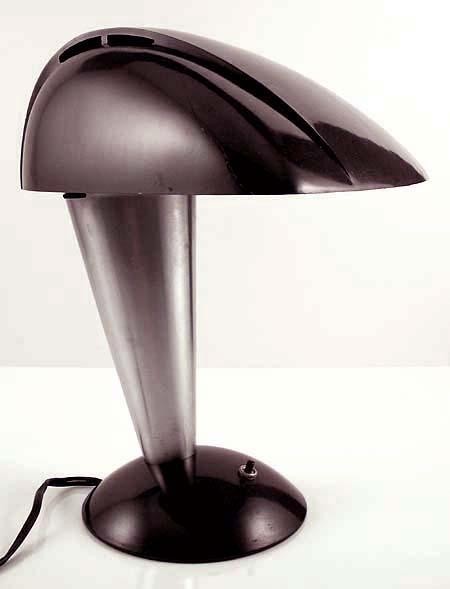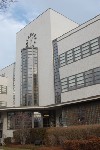Geometric Jewel on The Charles in Cambridge
784 Memorial Drive is Art Moderne Masterwork
By: Mark Favermann - Dec 06, 2008
Set between the innovative titans of Harvard and MIT along the banks of the Charles River is a geometric jewel of a building, 784 Memorial Drive. First built by B&B Chemical Company in 1937, and later purchased to house the then highly progressive and future-oriented Polaroid Corporation in 1939, this structure remains 70 years later a rare stylistic statement of a distinctive form of Art Deco called Art Moderne.
Art Moderne is a type of architecture that was popular in the United States from 1925 to around 1980. Though sometimes confused with the generic term Art Deco and even though there are some similarities between the two styles, one stylistic difference is that Art Moderne uses horizontal orientation and Art Deco uses vertical orientation.
The two things they do share are stripped down forms and geometric-based ornament. Not only that but Art Moderne also has its own unique streamlined look, which is emphasized by the use of rounded window glass that curves around that corners of buildings.
The early years of the twentieth century were filled with ultimate promise, fueled by increasing prosperity and energized by emerging technology. A new age seem to demand a new architecture that reflected this environment. This architecture eventually was labeled Art Deco.
Art Deco is a grouping of several styles of buildings and objects which, in their time, were simply considered "modern". Like today, there were many ideas as to what "modern" should look like. The Exposition Internationale des Arts Decoratifs et Industrials Modernes (Paris, 1925) set the stylistic tone of early Art Deco. The initial outgrowth of this period was the design and contruction of buildings based on earlier, neo-classical styles but with the application of exotic motifs such as flora and fauna.
Using grids, curves, and chevrons, these structures typically were arranged in geometric patterns. The buildings were often visually theatrical, luxurious, elegant and dramatic while appealing to ordinary people. However, architectural critics often disparaged Art Deco buildings as too superficial.
Though the Paris Exposition served as a notable key event, it was not the beginning of this stylistic trend. By 1925, there were numerous buildings incorporating elements that would find their way into the Art Deco style. A major structure was Eliel Saarinen's train station in Helsinki, Finland (1904-1914). With its four, giant figures holding a globe of light, it is the very essence of later Art Deco.
The first Art Deco skyscraper was seen in lower Manhattan with the opening of the Barclay-Vescey building in 1923. It was one of several buildings commissioned by the Bell Telephone System. Here, modern technology was to be housed in modern architecture. Art Deco structures proliferated during the 1920's and 30's. the style was expressed in designs for ornate banks, shops, hotels, restaurants, movie theatres. In more restrained ways, it was applied to schools and other civic buildings.
The Great Depression's effects were rapid and rather severe. After peaking in 1929-30, the era of the Art Deco skyscraper receded. A consequence of The Depression was the emergence of a streamlined Art Moderne as a reaction to the more gaudy and sometimes more colorful Art Deco and a straightforward reflection of austere economic times. Unnecessary ornamentation was gone, sharp angles were replaced with aerodynamic curves. The high points of the streamline, futuristic movement were Chicago's Century of Progress World's Fair of 1933-1934 and the New York World's Fair of 1939-1940 with its World of Tomorrow. The 784 Memorial Drive 1937 structure is part of this stylistically infused period.
Some other characteristics of Art Moderne buildings include rounded edges, corner windows, glass wall blocks, mirrored panels, ribbon or band windows with metal frames, string course along coping of wall, flat roof, curved canopies, smooth wall finishes, and elegantly detailed simplified railings, balusters, and door and window trim often fabricated with either aluminum or stainless steel. Many of these can be seen in the design and details of 784 Memorial Drive.
Art Moderne buildings can stylistically be characterized by a simpler geometric design than earlier Art Deco structures. They are often white or off-white with flat roofs, and can incorporate a variety of basic building materials including concrete, metal, stucco, glass blocks, and bricks. Patterning and simplified details all work together to create a consistent whole. Most of these buildings have a curved feature with little to no ornamentation. The effect the building gives is a windswept or streamlined one. This often underscores a futuristic appearance.
Art Moderne was most prevalent during the 1930's to the 1950's. Although only a few homes were designed throughout the US for progressive-minded individuals in this style, a large number of movie theaters, diners, and even gas stations were built in this manner. Ubiquitous Streamlined 1950's diners are a prime example of Art Moderne architecture. After WWII, the "e" was seldom used at the end of the word "modern."
The style illustrates the smooth, sleek appearance bridge from a more traditional architectural period to a future-oriented modern time. It was a prelude for today's contemporary more minimalist art, design and architecture. The style made strategic use of largely industrial materials to create functional, fluid contoured, simple geometric structures without fussy ornamentation. Focus was on the building as a whole rather than individual ornamentation. Function and form were literally smoothed out and streamlined.
Interestingly, 784 Memorial Drive has a distinguished somewhat traditional architectural linage as well. It was designed by the Boston-based firm of Shepley Bulfinch Richardson Abbott. The firm was founded generations ago by Henry Richardson Shepley, Francis Vaughn Bulfinch, Joseph Priestly Richardson, a grandson of the great H.H. Richardson of Boston's Trinity Church and Harvard's Sever Hall, and Lewis B. Abbott.
Still active today as SBRA Architects, the architectural firm dates its family tree to The Office of H.H. Richardson (1874-1886), Shepley Rutan and Coolidge (1886-1915), Coolidge and Shattuck (1915-1924), Coolidge Shepley Bulfinch and Abbott (1924-1952) and Shepley Bulfinch Richardson and Abbott (1952 to present).
The Coolidge Shepley Bulfinch and Abbott incarnation designed 784 Memorial Drive. It also created other Art Moderne structures like airport terminals and other office buildings. Though something of a period piece, 748 Memorial Drive building is truly a masterwork.
Also designed in the streamlined style, an elegant desk lamp that was produced by Polaroid about the time the company moved into 748 Memorial Drive. The design is attributed to Walter Dorwin Teague in 1937. Polaroid manufactured the lamp from 1937 until 1939 and from 1939 until 1941 it was produced for them by the Mitchell Company.
Industrial design pioneer Teague had been approached by the company to redesign a smaller Polaroid study lamp product which in its previous form featured a bakelite stem and a fabric shade. It is not clear if the new design was done by Walter Teague himself or one of his employees, designer Frank Del Guidice (1917-1993). As the design turned out to be very successful, it apparently convinced Polaroid's owner, Edwin Land, of the value of not only industrial design, but of Teague's office in particular. Teague went on to design cameras for the companyfor decades including the popular elegant SX-70. Thus streamline design was a corporate inclination.
Over time, the Art Moderne streamlined style came to occupy a small, but influential, part of the dominant mid-20th Century International Style. Alas, for the most part, time has not been kind to Art Deco and Streamline Moderne architecture. Throughout major and mid-sized American cities, great and not so great Art Deco skyscrapers, with their intricate details, were expensive to maintain and often sat on valuable real estate.
Though prominent Art Deco buildings survive, the majority were less valued than their real estate, so a few were torn down. With the streamline Art Moderne buildings the reverse was often the case. With many buildings located in more marginal neighborhoods rather than downtowns and very often lacking needed maintenance for decades, they were often cleared away for more neutral and boring structures. They are all but forgotten.
That is what makes 784 Memorial so rare, and by New England standards, virtually unique. After Polaroid's corporate demise, over the years, various high tech, bio-tech and medical research companies have leased the building. The progressive appeal of the structure still visually and perhaps viscerally vibrates. Here along the Charles River is a geometric beauty.

